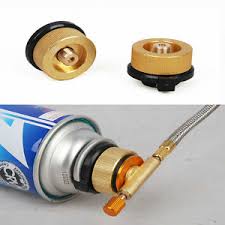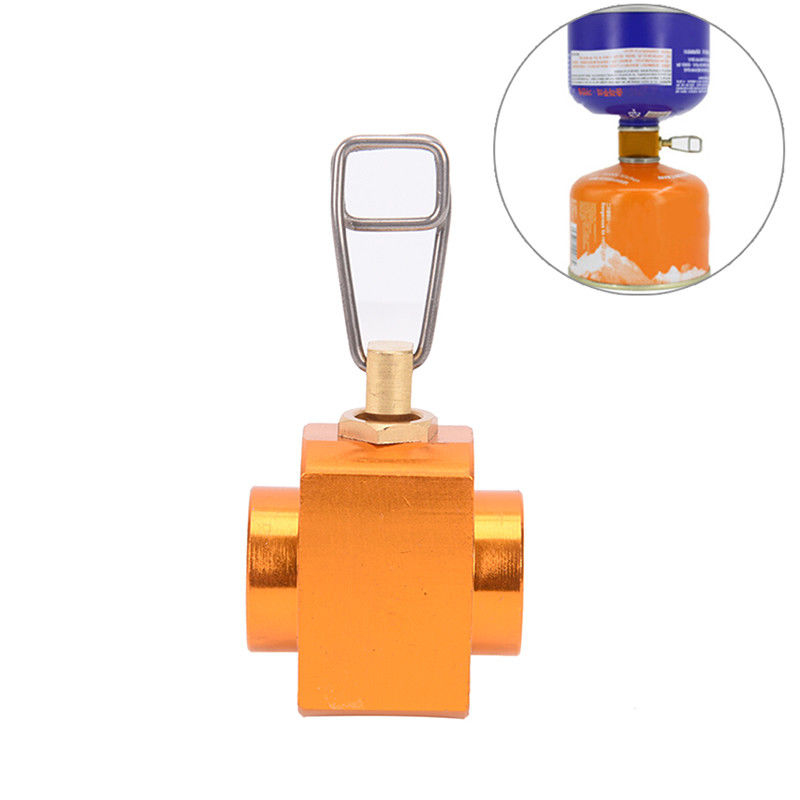Topic
Butane refill fail – obvious in retrospect!
Forum Posting
A Membership is required to post in the forums. Login or become a member to post in the member forums!
Home › Forums › Gear Forums › Gear (General) › Butane refill fail – obvious in retrospect!
- This topic has 16 replies, 8 voices, and was last updated 5 years, 1 month ago by
 David Thomas.
David Thomas.
-
AuthorPosts
-
Mar 24, 2019 at 6:00 pm #3585279
For a while I’ve been refilling standard camping iso-butane/propane cylinders with butane from various types of containers. Note: do NOT refill with propane unless you have a chemical engineering lab at home, as the propane vapor pressure is high and overfilling can lead to a cylinder rupture (and possibly your very own Hollywood special effects explosion, but with you at the center).
I use the following to convert from portable stove butane cylinders to a Lindahl valve (under $3 on Ebay or AliExpress):

I then use the following to connect Lindahl-to-Lindahl (under $3 on Ebay or AliExpress):

This works fine if the I empty the source cylinder into the receiving cylinder, just unscrew the adapter off the now-filled cylinder when done.
But what if you don’t completely empty the source cylinder? I figured it would be easy to just unscrew both sides very quickly and have minimal leaks.
Wrong!!!
I tried unscrewing both simultaneously. I got one off and then my hands got sprayed with extremely cold and rapidly evaporating liquid butane. I continued unscrewing as fast as I could, but by the time I was done one of my hands got sprayed a lot and it stung a fair amount. Fortunately, I was fine in about an hour, with no evidence of frostbite. Also, I was clever enough to attempt to separate the two cylinders outside the house.
A solution is to use an adapter with a valve, like this one ($4.34 on Ebay incl. shipping):

This seems to work fine, nothing comes out the other end if the valve is closed. You can spend up to $35 for similar adapters, I don’t know why they are any better.
Side note: my strategy to move butane from one cylinder to the other quickly is to first put the receiving cylinder in the freezer for a while, then VERY CAREFULLY use a heat gun on the source cylinder. I gently heat it on the lowest setting for 5 seconds or less, then repeat once in a while, always touching the source cylinder to make sure it doesn’t get too hot.
Mar 24, 2019 at 7:35 pm #3585283That sounds entertaining. In that you survived without permanent injury.
I call the one’s used for backpacking “canisters” (since it says that on the side)
and similarly, the ones you buy at the Korean grocer ($1.25 for 8 ounces) for portable stoves “cartridges”
That middle connector you mentioned (without valve) sounds dangerous. I use the last connector (with valve). For transferring canister to canister
I used one like the first one you mentioned but it broke, now I use https://www.amazon.com/Xinnyuan-Inflation-Connector-Cylinder-Pneumatic/dp/B07C9Z8F31/ref=sr_1_fkmrnull_1?keywords=Butane+Tank+Connector+Cylinder+Coupler+Gas+Refill+Adapter+Pneumatic+Valve&qid=1553455259&s=sporting-goods&sr=1-1-fkmrnull
“Xinnyuan Outdoor Copper Quick Inflation Butane Tank Connector Cylinder Coupler Gas Refill Adapter Pneumatic Valve”
$3.85. There are several other models that I assume are equally good

I like the simplicity. No valve. You just push them together to transfer, pull them apart and only a little gas escapes.
Rather than upside down like in the photo, I hold them sideways with the notch down to get all of the butane out of it. Heat up the cartridge first in a bowl of water, 120F. Weigh the receiving canister and make sure you don’t fill it more than the allowed weight. 8 ounce canisters weigh 5 ounces empty, so it shouldn’t be more than 13 ounces full. 4 ounce canisters weigh 3 ounces empty so 7 ounces full.
Mar 24, 2019 at 8:00 pm #3585286Jerry: I bought one of those little guys and it came without one of the o-rings, I got a full refund and just forgot about it after I purchased the one that failed above. Maybe I’ll find an o-ring and give it a try. We’ll see how long the one with the valve lasts.
Also, I was worried about eye protection prior to the failure, and I wear glasses, so I guess I was covered. At the national labs I used to work at you had to wear eye protection, face mask, long pants and sleeves, and cryo gloves to deal with such liquids. Of course we were moving large quantities of liquids such as LN2, LAr, LHe, LCO2, and on occasion LH2, so ODH concerns were very important, and LH2 is highly flammable.
Mar 24, 2019 at 8:53 pm #3585292Both of you are very entertaining from the safety of the audience. I have no plans to join you on the stage, however.
I just don’t have the knowledge, skills and smarts to do what you are doing without hurting myself.
Mar 24, 2019 at 10:28 pm #3585310if either of us suddenly quit posting, you’ll know why : )
Mar 24, 2019 at 11:26 pm #3585319Have fun.
Mar 25, 2019 at 1:24 am #3585351I found the videos following the gas cylinder explosion very funny.
My favs were the explosives that didn’t make it far from the tube or hand of the thrower.
Good to know that correctly dug holes can protect a thrower from a mis thrown grenade.
Mar 25, 2019 at 1:25 am #3585352Can someone explain to me why this is a thing?
Mar 25, 2019 at 1:43 am #3585353Is this why people want big yards? So they don’t kill the neighbors.
Mar 25, 2019 at 2:32 am #3585358I live on 13 acres, but still opt for the adapter with a valve. I find putting the receiving canister in the freezer suffices. Heating the donor to 120F as well would, I’d guess, let transfer happen in 5 seconds instead of 30 seconds but 30 seconds is fine with me.
When I disconnect a canister, that canister is always upright so that any little bit that vents is gas, not liquid.
Every new canister I buy gets its full weight recorded to the nearest gram in laundry marker. Whenever any get empty, I record the empty weight, too.
Mar 25, 2019 at 4:10 pm #3585409David: I also weigh things, but not quite as carefully as you do.
I once waited a long time for the butane to transfer down to the receiving canister from the source cartridge (thanks to Jerry for correct terminology), maybe I didn’t freeze the receiving canister long enough. Anyway, I tried the heat gun and it worked great. I’ll give it a try again w/o the heat gun again.
Matt: Why is this a thing? I am cheap, to start. I also like to tinker and figure things like this out. My next new thing is to refill my propane torch cylinder from a large, grill cylinder, it’s maybe ten times cheaper that way (the fact that one cylinder lasts me about five to ten years doesn’t seem to make a difference ;-) ).
At least I’m not going to explode a cylinder in a fire (or so says my wife…).
Mar 25, 2019 at 4:53 pm #3585415I disagree with David, just for the sake of arguing
It’s easier to heat up the donor canister/cartridge – heat up water until hot to touch in microwave, maybe 30 seconds, then put canister/cartridge in it for 2 minutes. I think there’s more energy at the warmer temperature. But either way works fine : )
I don’t know that canister and cartridge are the definitive names, just what I read on the outside, wanted my text to be unambiguous : )
I used to weigh like David, but I’ve gotten lazy, empty 4 ounce canister = 3 ounces, 8 = 5 ounces, close enough. I typically do 6 days, 1 ounce per day + 1 extra ounce = 7 ounces total, no where near upper limit of canister, and if the extra ounce is actually 0.8 ounce that doesn’t matter. I have one brand of canister that actually weighs 5.19 ounce empty.
If I wanted to do 8 days on an 8 ounce canister, I might be more careful about the actual empty weight and put exactly 0.5 ounces extra. Make sure it didn’t get above room temperature. That would be within margin.
I too am a proud cheapskate and like to fiddle.
If I used those 1 pound propane canisters more I’d consider refilling them from a bulk tank.
Mar 25, 2019 at 5:20 pm #3585420“I too am a proud cheapskate and like to fiddle.”
I think you and I might be twin sons of different mothers, Jerry. I could include David here, but I can attest that he is NOT a cheapskate (though he can fiddle with the best of them).
I’ve got an acre of safe ground here, and Bob Moulder and the rest of you almost convinced me that I had to try re-filling canisters with Korean butane a couple of years ago. Then I realized that I likely have a lifetime’s worth of full fuel canisters (that’s what I tend to buy with my 20% off REI coupons), and I happen to like having a good amount of propane in the canisters for cold nights. So I am content with fiddling with other geeky projects.
Mar 25, 2019 at 8:50 pm #3585456“I am cheap, to start. I also like to tinker and figure things like this out.” – Elliot
Aaahhh … I completely get it, now! My projects don’t blow me up (yet), but I certainly understand the drive.
Mar 26, 2019 at 8:29 am #3585533I save a bit of money refilling $5.99/100-gram butane-blend canisters from $8.99/450-gram canisters. More so, I can do custom fills as Jerry describes.
I save more each year refilling $4-$5, 1-pound propane canisters (the heavy, steel, green Coleman one’s) with $0.65 of bulk propane from one of my four 20-pound cylinders. I just coached one math contest and visited two toxic waste sites, driving 1130 miles in 2 days without crossing any state lines, so I’ve broken no federal laws.
Mar 26, 2019 at 1:11 pm #3585546So, the big tanks have no devices that prevent liquid from flowing? You just have to turn it upside down?
Heating it might be difficult because it’s so big, better to cool receiving canister?
Mar 26, 2019 at 2:54 pm #3585569Jerry, I’m usually using a 20-pound / “5-gallon” (really 4.4 gallons) BBQ propane tank that is full enough that I can lay it on its side and still get a liquid feed.
I’ve done vapor transfers, but then you have to cool the receiving cylinder repeatedly to have enough “cold capacity” to condense the transferred vapor.
-
AuthorPosts
- You must be logged in to reply to this topic.
Forum Posting
A Membership is required to post in the forums. Login or become a member to post in the member forums!
Our Community Posts are Moderated
Backpacking Light community posts are moderated and here to foster helpful and positive discussions about lightweight backpacking. Please be mindful of our values and boundaries and review our Community Guidelines prior to posting.
Get the Newsletter
Gear Research & Discovery Tools
- Browse our curated Gear Shop
- See the latest Gear Deals and Sales
- Our Recommendations
- Search for Gear on Sale with the Gear Finder
- Used Gear Swap
- Member Gear Reviews and BPL Gear Review Articles
- Browse by Gear Type or Brand.






